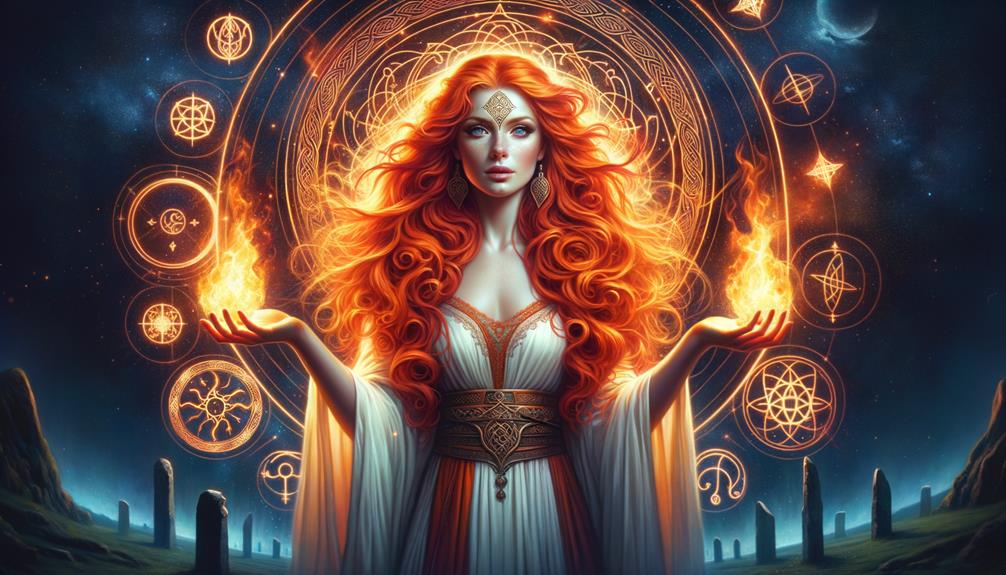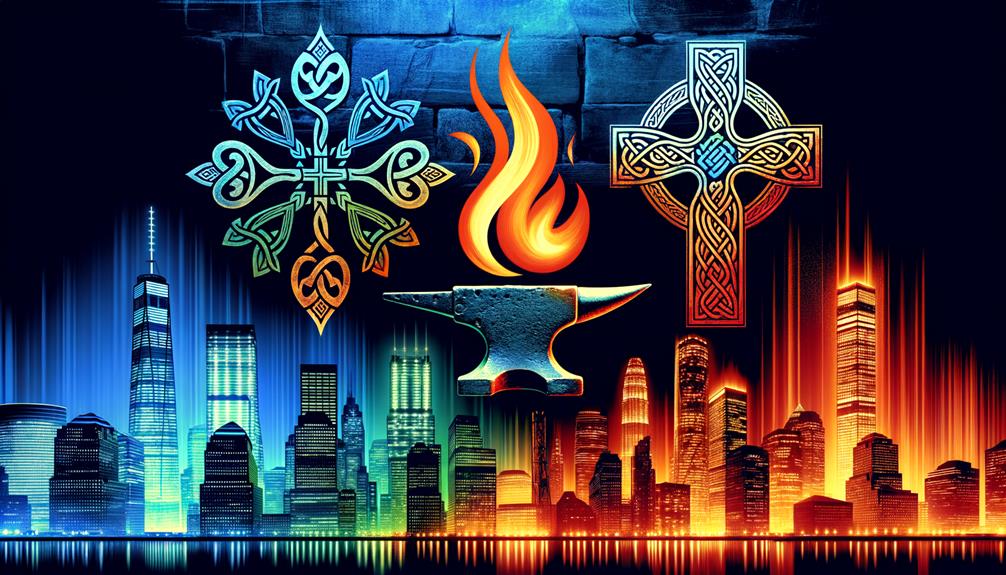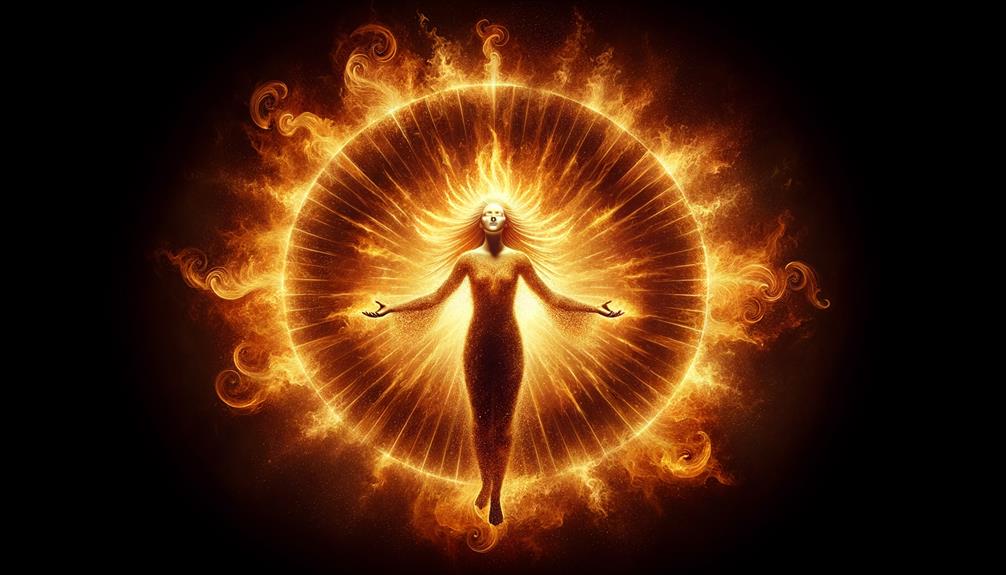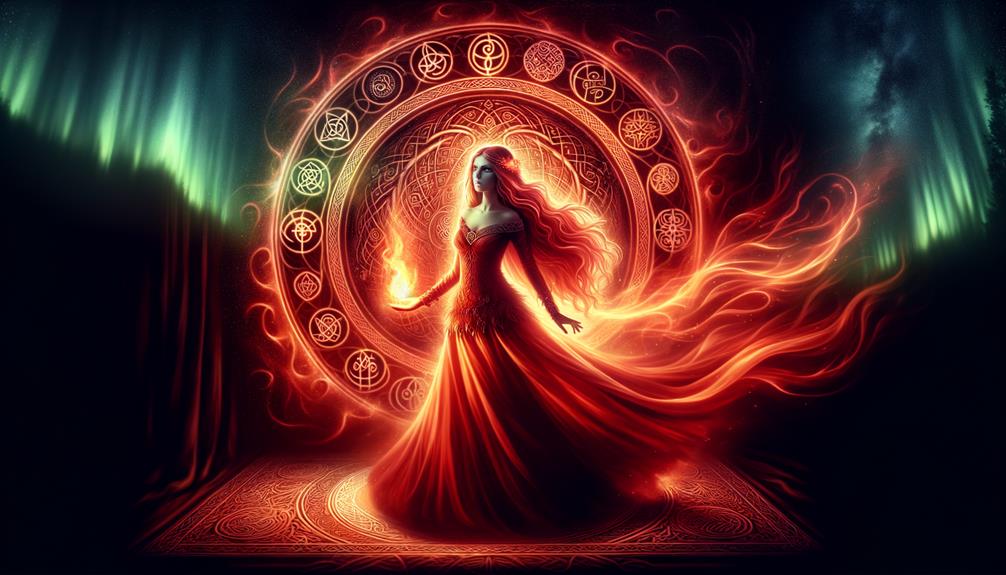Let's follow the patterns of the Brigid's Cross, a symbol tied to the fascinating Brigid, the goddess of fire in Irish lore. Her story is not just about divine might and influence, but also reflects her position as a source of inspiration, healing, and safeguarding. Brigid was deeply connected to the rhythms of nature and farming, and it was thought that she could bless crops and ensure a bountiful harvest. Despite being honored as a saint and worshipped through rituals and symbols, there's an unexplored depth to Brigid's story. Are you set to reveal the significant impact of this fiery goddess on our cultural and spiritual rituals?
The Origin of Brigid

So, you're curious about Brigid's origins, huh? Well, it's quite a story, layered with myths and historical facts. Turns out, Brigid wasn't just one goddess, but possibly a name shared by three sisters. These women were no ordinary siblings – they symbolised wisdom, healing, and craftsmanship. As a Celtic goddess, Brigid was admired for her intelligence and seen as a guardian of poets. Documents like the Lebor Gabála Érenn describe her as Dagda's daughter, an Irish god, and link her with domestic animals. That's a clue to how deeply she was woven into old Irish day-to-day life.
But the story doesn't end there. The pagan Brigid and Saint Brigid, a Christian figure from Ireland with the same name, later became merged into one. Now, this saint is known for many things – she's the protector of professions from healing and poetry to blacksmithing, and even livestock and dairy farming, signalling the onset of spring. 'Brigid's fire', a key symbol in both her Celtic and Christian forms, speaks to her power of transformation.
Even as Ireland adopted Christianity, Brigid's influence didn't wane. She went from being a respected Celtic deity to a renowned Christian saint, and her fame spread beyond Ireland. Even today, she continues to be celebrated – by committed Christians and contemporary pagans alike. These diverse followers appreciate her intricate personality and the many roles she embodies.
Brigid's Divine Domains

Brigid's roots in history are as captivating as the many divine domains she rules over. These domains are a testament to her different roles as a defender, healer, and wisdom symbol. Known as Brigid of Kildare in Irish folklore, this deity is connected with fire and water, elements that signify creation and change. Her three-fold nature, a recurring concept in Celtic mythology, indicates her broad reach across various life aspects.
- Brigid as a healer: She is respected for her healing abilities and her power to provide peace and wellness.
- Goddess of fire: In her role as a fire goddess, she personifies passion, creativity, and knowledge. This role also covers poetry and grand architecture, showing her support for innovation and intelligence.
- Fertility and motherhood: Her association with fertility, domestic animals, and motherhood showcases her nurturing character.
As the dawn goddess in Indo-European belief, Brigid's influence is not limited to Ireland but is worldwide, showing her continued importance in both modern Pagan and Christian customs. Brigid, the multifaceted goddess of fire, healer, and wise woman, still shines brightly and inspires many, solidifying her place among respected deities.
Legends and Folktales

Let's chat about the fascinating world of legends and folktales, focusing on the incredible power and influence of Brigid, a figure deeply embedded in various cultural aspects. She's famous for her connections to healing, poetry, fire, and domesticated animals. Brigid isn't just any old goddess; she's known as the Goddess of Healing. Her story is a staple of the Celtic pantheon, and her fire, known as the Flame of Ireland, shines brightly.
In the devotion to Brigid, her sacred fire was always kept lit, a symbol of her constant presence. There's this old Irish story about the Tuatha that features Brigid in a prominent role, underlining her importance. She's not just an Irish figure; her links to the ancient British goddess Brigantia show her influence reached far beyond Ireland.
Brigid also holds the title of the Goddess of Poetry. Her tales are filled with a unique kind of magic, conveying wisdom and inspiration. The impact of these ancient stories is still felt today in modern Celtic spirituality and pagan practices. The ongoing devotion to Brigid, particularly during the Imbolc festival, keeps the Flame of Ireland bright and alive. Through these tales, Brigid's sacred fire continues to burn in the hearts of her followers.
Brigid in Modern Culture

Brigid's impact on contemporary culture is still felt today, especially among those drawn to Celtic spirituality. As the Goddess of dawn, fire, and poetry, Brigid occupies a special place in Celtic lore. Even now, her story as the fire goddess continues to inspire and strike a chord with modern-day pagans.
Her impact can be seen in three prominent ways:
- The Brigid Cross: This emblem, which symbolises protection and a divine link, is still prominently featured in artwork and used as a spiritual symbol.
- Fire Temples: Modern pagans pay their respects to St Brigid by maintaining fire temples. Here, her flame is kept burning constantly, symbolising her power to bring about change.
- Brigid's Day: This festival, observed on the first of February, signifies the onset of spring. It's a time for cleansing and renewal, which is a nod to Brigid's own mythology.
Embracing Brigid's Influence

Let's get to know Brigid and her impact a little better. Brigid is no ordinary figure. She's a triple threat, associated with wisdom, art, and healing. Here's an interesting tidbit – she is the daughter of the Dagda, making her a key player in Irish mythology. People don't just see her as a goddess; they revere her as a saint too. To get a grasp on her influence, it's crucial to understand how she transitioned from a pagan goddess to a Christian saint.
Imbolc, a festival marking the first day of spring, is closely tied to Brigid. It represents her as a symbol of change and fresh starts. A traditional ritual performed in her honor is the lighting of fires, signifying her link with transformation and cleansing.
Across Ireland, there are holy wells known for their healing properties, and guess what? They're attributed to St. Brigid. This shows her influence in the areas of healing and nature. Maintained by Christian monks, these wells perfectly blend the pagan and Christian sides of Brigid's identity.
Frequently Asked Questions
What Is the Story of the Goddess Brigid?
Brigid is a beloved figure in the realm of Celtic mythology, highly praised for her wisdom and her role as a supporter of poets. She was later associated with a Christian Saint, which allowed her legacy to endure for centuries. Present-day followers of pagan traditions continue to pay homage to her, marking her significance with the observance of the Imbolc festival and the creation of Brigid's Cross.
Is Brigid a Fire Goddess?
Isn't it amazing how stories from the past keep changing and adapting? Absolutely, Brigid is a fire goddess from old myths. She's tied to the concept of a home's fireplace, the creation of poetry, and the process of healing, showing how she cares for and shields others. What's really impressive is that people still feel her presence today.
What Does Brigid Symbolize?
From what I gather, Brigid is all about the dynamic forces of creation and change. She embodies the spark of inspiration, the healing touch, the richness of fertility, and the depth of wisdom. You can see her connection to fire as a symbol for cleansing, for bringing light to places that are obscure or hidden.
Who Is the Goddess Brigid's Son?
Do you know who Brigid's son is? Well, let me tell you, it's Ruadán. You might recognize his name from Irish mythology, especially due to the crucial part he played in the Second Battle of Moytura. But that's not all. His passing didn't just lead to peace but also started the tradition of keening. This, in turn, further emphasized Brigid's association with peace. Isn't that interesting?

